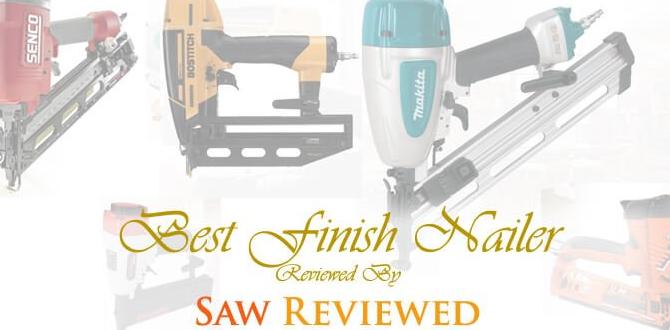Quick Summary:
Using a brad nailer offers incredible advantages for woodworking and DIY projects. It provides faster assembly, cleaner finishes, better precision, and reduced hand fatigue compared to traditional nailing. It’s an essential tool for anyone looking to achieve professional-looking results with ease and efficiency.
Hey there, DIY enthusiasts and aspiring woodworkers! Jack Shaffer here from Nailerguy. Ever found yourself staring at a woodworking project, picturing that perfect finish, but dreading the tedious task of hammering in hundreds of tiny nails? It’s a common frustration, especially when you’re aiming for a professional look without spending all day on basic assembly. But what if I told you there’s a tool that can make this part of your projects a breeze? That’s where the humble brad nailer comes in. It’s a game-changer, and I’m excited to show you exactly why. In this guide, we’ll dive deep into the proven benefits that make a brad nailer an absolute must-have for your toolkit. Get ready to tackle your next project with more speed, accuracy, and a whole lot less effort!
Table of Contents
Unlocking the Power of the Brad Nailer: Proven Benefits for Your Projects
As your go-to guy for all things nailers, I get asked a lot about which tools are truly worth the investment, especially for those just starting out. The brad nailer often comes up, and for good reason. It’s a versatile, efficient, and remarkably user-friendly tool that can significantly elevate your woodworking game. Forget struggling with a hammer and tiny nails that bend or miss the mark. A brad nailer is designed to make your life easier and your projects look fantastic. Let’s explore the core advantages that make this tool a standout in any DIYer’s arsenal.
1. Unmatched Speed and Efficiency
This is often the first thing DIYers notice and appreciate about brad nailers. Imagine having to join multiple pieces of trim, assemble cabinet doors, or build a picture frame. If you were to use a hammer and brad nails, each nail would require a precise placement and a careful hammer swing. This process, repeated dozens or even hundreds of times, can be incredibly time-consuming. A brad nailer, on the other hand, fires nails in a fraction of a second. You simply position the tool, line up the nail head with the surface, and pull the trigger. The nail is driven flush, ready for the next one. This dramatic reduction in task time allows you to complete projects much faster, freeing you up for other creative endeavors or simply enjoying the satisfaction of a job well done.
Consider a project like installing baseboards or crown molding. These jobs involve many linear feet of material and require numerous nails to secure them properly. A brad nailer can cut the fastening time for such a project by more than half, making a previously daunting task much more manageable, especially for homeowners tackling renovations or upgrades themselves.
2. Superior Precision and Control
Achieving a clean, professional look often comes down to precision. When you’re hammering, it’s easy to hit too hard, drive the nail too deep and create an unsightly divot, or hit too softly, leaving the nail head proud of the surface. Trying to fix these mistakes can be frustrating. Brad nailers offer a level of control that’s hard to match with manual hammering. Most brad nailers allow you to adjust the depth of the nail penetration. This means you can set the nail to be driven perfectly flush with the wood surface, slightly countersunk for a cleaner look, or even just enough to hold securely without damaging delicate trim.
This precision is especially critical when working with thin or soft woods, or when attaching delicate trim pieces that could easily split or splinter under the force of a hammer blow. The controlled, consistent drive of a brad nailer ensures each fastener secures the material effectively without causing damage. This level of accuracy translates directly into a more polished and professional final product, something every DIYer strives for.
3. Cleaner Finishes, Less Filling
We all want our projects to look smooth and flawless. Hammering nails can inevitably lead to cosmetic imperfections. You might dent the wood around the nail head, miss your target and create multiple holes, or drive nails in a way that’s visibly uneven. These issues often require extra steps like filling nail holes with wood putty, sanding, and repainting or refinishing. With a brad nailer, especially when the depth adjustment is set correctly, the nail head can be driven precisely flush or slightly below the surface. This minimizes the need for extensive cosmetic touch-ups. In many cases, the small, clean holes left by brad nails can be easily filled with a bit of matching putty or even covered by paint, resulting in a much cleaner and more professional-looking finish without all the extra labor.
This benefit is a huge time-saver. Instead of spending precious time patching and sanding, you can move directly to the finishing stages, like painting or staining, much sooner. For trim work, molding, or furniture assembly where appearance is paramount, the clean aesthetic provided by a brad nailer is a significant advantage.
4. Reduced Hand Fatigue and Strain
Let’s be honest, repetitive hammering can be physically demanding. Swinging a hammer, especially for extended periods or when working in awkward positions, can lead to sore wrists, hands, and even cause blisters. This physical strain can make larger projects feel overwhelming and may even discourage some DIYers from attempting them. A brad nailer takes the hard work out of fastening. It uses compressed air (in pneumatic models) or a battery-powered motor to drive the nail, requiring only a light pull of the trigger. This drastically reduces the physical exertion needed for fastening tasks.
This is particularly beneficial for individuals who may not have the physical strength for prolonged hammering, or for anyone looking to make their DIY projects more accessible and enjoyable without the risk of injury or excessive fatigue. Imagine installing miles of decorative trim or building several bookshelves – a brad nailer makes these tasks feasible and far less taxing on your body.
5. Versatility for a Wide Range of Materials and Projects
While they use small nails (typically 18-gauge, hence the name “brad”), these nailers are surprisingly versatile. They excel at attaching delicate trim, molding, baseboards, and crown molding. They are also fantastic for building cabinet boxes, assembling drawers, creating picture frames, installing paneling, and even working on small furniture projects. Because brad nails are slim and leave minimal impact, brad nailers are ideal for hardwoods and softwoods alike, as well as engineered wood products like MDF and particleboard, where a hammer and nail could easily cause splitting or damage.
Their ability to work with a variety of wood types and project scopes makes them a true workhorse. Whether you’re a seasoned woodworker building custom cabinetry or a homeowner refreshing your interior trim, a brad nailer can adapt to your needs. The size of the nail head also means they are less obtrusive than framing nails or even finish nails used by larger nailer types, allowing for a cleaner aesthetic in visible applications.
6. Consistent Fastening Strength
When you drive a nail with a hammer, the depth and force can vary from one strike to the next. This can lead to some nails being driven too shallowly, providing weak holding power, while others might be driven too deeply, potentially compromising the integrity of the material or not holding effective. A brad nailer, when properly calibrated, drives each nail to a consistent depth and with consistent force. This ensures that each fastener provides the intended holding strength, leading to more durable and reliable constructions. You can trust that your joints will hold securely, which is crucial for the longevity and safety of your projects.
For furniture making, cabinet construction, or any structural applications on a smaller scale, consistent fastening is key. This reliability adds a layer of professional quality to your work, giving you confidence in the durability of your creations. This consistency is a hallmark of professional craftsmanship that any DIYer can achieve with the right tools.
7. Can Utilise Different Types of Brad Nails
While the tool itself is a brad nailer, it can typically drive different types of nails that fall within the brad category. The most common are standard brads, which have a very small head, and slightly larger headed brads, sometimes called “repin brads” or “panel nails,” which offer a bit more holding power while still maintaining a relatively small and unobtrusive profile. Some nailers may even be capable of driving headless pins, which are even smaller and leave almost invisible holes, perfect for delicate decorative work.
This adaptability means you can select the best fastener for the specific job. For instance, when attaching thin decorative trim where minimal visibility is key, you might opt for the smallest brads or headless pins. For assembling drawer boxes where slightly more holding power is needed, you might use a slightly larger or more robust brad. This choice of fastener, powered by the brad nailer, allows for a tailored approach to each task, ensuring optimal results.
Types of Brad Nailers and Their Advantages
Before we dive deeper, it’s helpful to understand that brad nailers come in a few main varieties, each with its own set of advantages. Knowing these will help you choose the right one for your needs and fully leverage its benefits.
Pneumatic Brad Nailers
These are the most common type and are powered by compressed air from an air compressor.
Advantages:
- Power and Consistency: Generally offer the most power and consistent drives.
- Lightweight Tool: The tool itself is often lighter as the compressor does the heavy lifting and air storage.
- Durability: Often built for heavy-duty, prolonged use.
- Cost-Effective (Long Term): While there’s an upfront cost for a compressor, the nailer and nails can be cheaper than other types over time.
Electric (Corded) Brad Nailers
These plug directly into a standard electrical outlet.
Advantages:
- No Compressor Needed: Great for small workshops or users without an air compressor.
- Easy to Use: Simple plug-and-play operation.
- Consistent Power: Power delivery is stable as long as the power supply is consistent.
Considerations: The cord can sometimes be a minor nuisance, and they might be slightly bulkier than pneumatic models. For an in-depth look at choosing power sources, check out resources like Family Handyman’s guide.
Cordless (Battery-Powered) Brad Nailers
These are self-contained units powered by rechargeable batteries.
Advantages:
- Ultimate Portability: No cords or hoses, offering maximum freedom of movement.
- Convenience: Ready to use almost anywhere.
- Fast Setup: Just grab and go.
Considerations: Can be heavier due to the battery pack, and battery life can be a factor for very long jobs. The initial cost is often higher. For more on battery technology in cordless tools, sites like Tool Authority offer insights.
Fuel Cell Brad Nailers
These use a combination of a small fuel cartridge and a battery to drive nails.
Advantages:
- Powerful: Offer good power and depth control.
- Cordless and Hose-less: Similar portability to battery models.
Considerations: Require ongoing purchase of fuel cells, and the exhaust can have a distinct smell.
Key Scenarios Where a Brad Nailer Shines
Let’s look at some specific project types where the advantages of using a brad nailer truly come to the forefront.
Trim and Molding Installation
This is arguably the most popular application for brad nailers. Installing baseboards, crown molding, window casings, and door frames requires numerous perfectly placed fasteners. A brad nailer allows you to quickly and accurately attach trim pieces, ensuring they sit flush against the wall or frame. The small nail heads are also easily concealed, resulting in a clean, professional finish that’s hard to achieve with a hammer. This dramatically speeds up renovation projects and yields results that homeowners can be proud of. For great tips on trim installation, the This Old House website offers excellent advice.
Cabinetry and Drawer Assembly
Building or repairing cabinets and drawers often involves joining thin panels and delicate joinery. A brad nailer provides the precise fastening needed to hold these components together while glue sets, or as a primary fastener in some designs. The ability to control nail depth is crucial here to avoid blowing through the thin plywood or MDF commonly used in cabinet construction. This ensures a strong yet aesthetically pleasing assembly. Building your own custom cabinets can save a significant amount of money, and a brad nailer makes the assembly process much more accessible.
Picture Frames and Small Decor Projects
For hobbyists and crafters, creating custom picture frames, decorative boxes, or other small wooden items is a common pursuit. Brad nailers are perfect for these tasks because they handle small pieces of wood with finesse. They prevent the wood from splitting and ensure that fasteners are unobtrusive, maintaining the delicate aesthetic of smaller projects. The speed and ease of use also allow for quick production if you’re creating items to sell or as gifts.
Furniture Restoration and Repair
When repairing furniture, sometimes you need to re-attach delicate trim, re-secure loose panels, or even reinforce joints. A brad nailer offers a less invasive way to perform these repairs compared to driving larger nails or screws that might be overkill for the original material. The precision of a brad nailer allows you to fasten components without causing further damage to antique or refinished pieces.
Comparing Brad Nailers to Other Fastening Methods
To fully appreciate the advantages, let’s see how brad nailers stack up against manual methods and other power tools.
| Feature | Brad Nailer | Hammer & Brads | Finish Nailer (e.g., 16-gauge) | Screwdriver/Drill |
|---|---|---|---|---|
| Speed | Very Fast | Slow | Fast | Moderate to Fast |
| Precision & Control | High (adjustable depth) | Low (depends on user skill) | High | Moderate (screws can strip) |
| Finish Quality | Excellent (minimal visible marks) | Fair to Poor (dents, visible heads) | Very Good | Good (can leave larger screw heads) |
| Material Risk (Splitting/Damage) | Low (small nail size) | Moderate | Low to Moderate | Moderate to High (if overtightened) |
| Fatigue/Effort |


